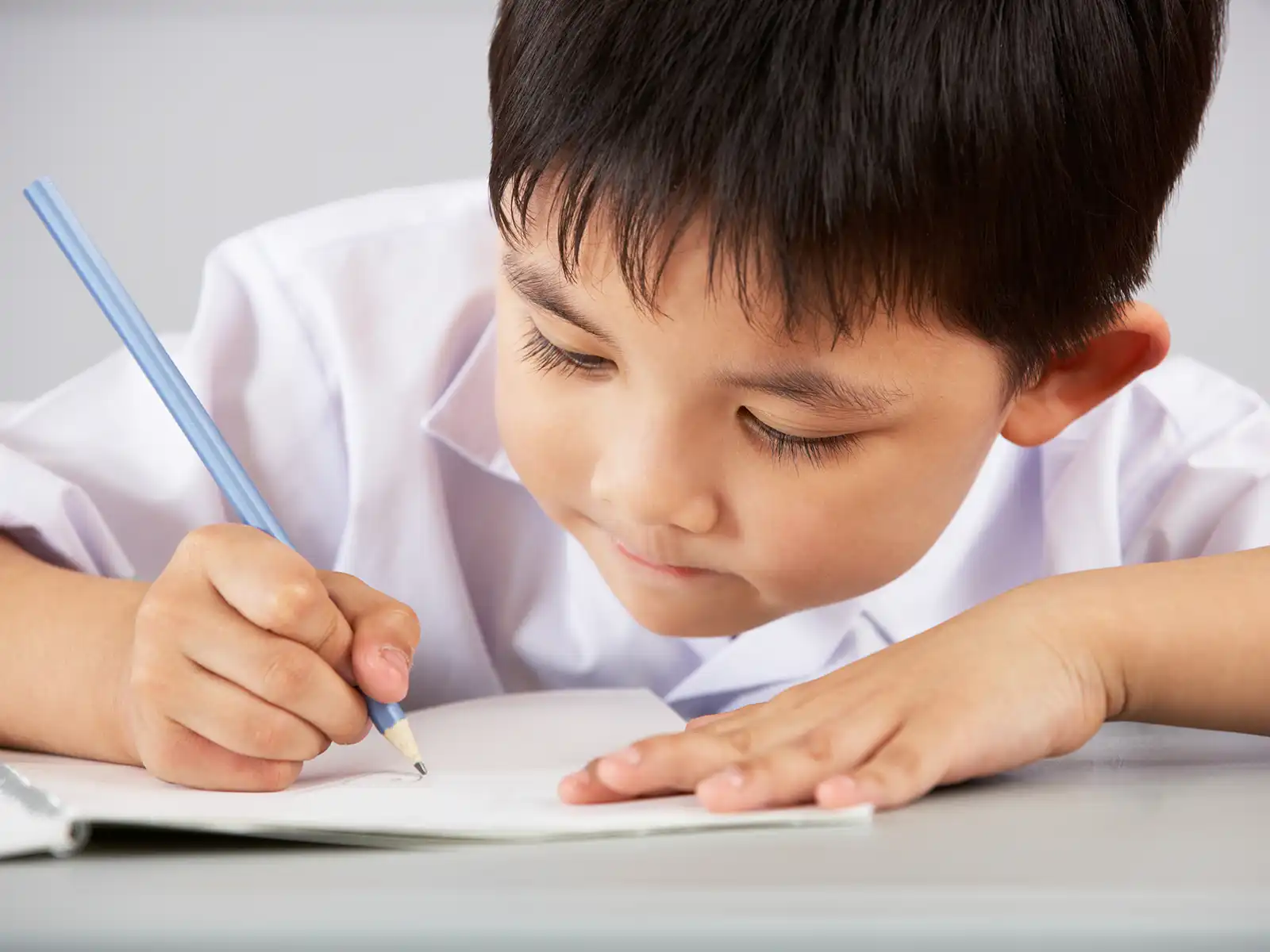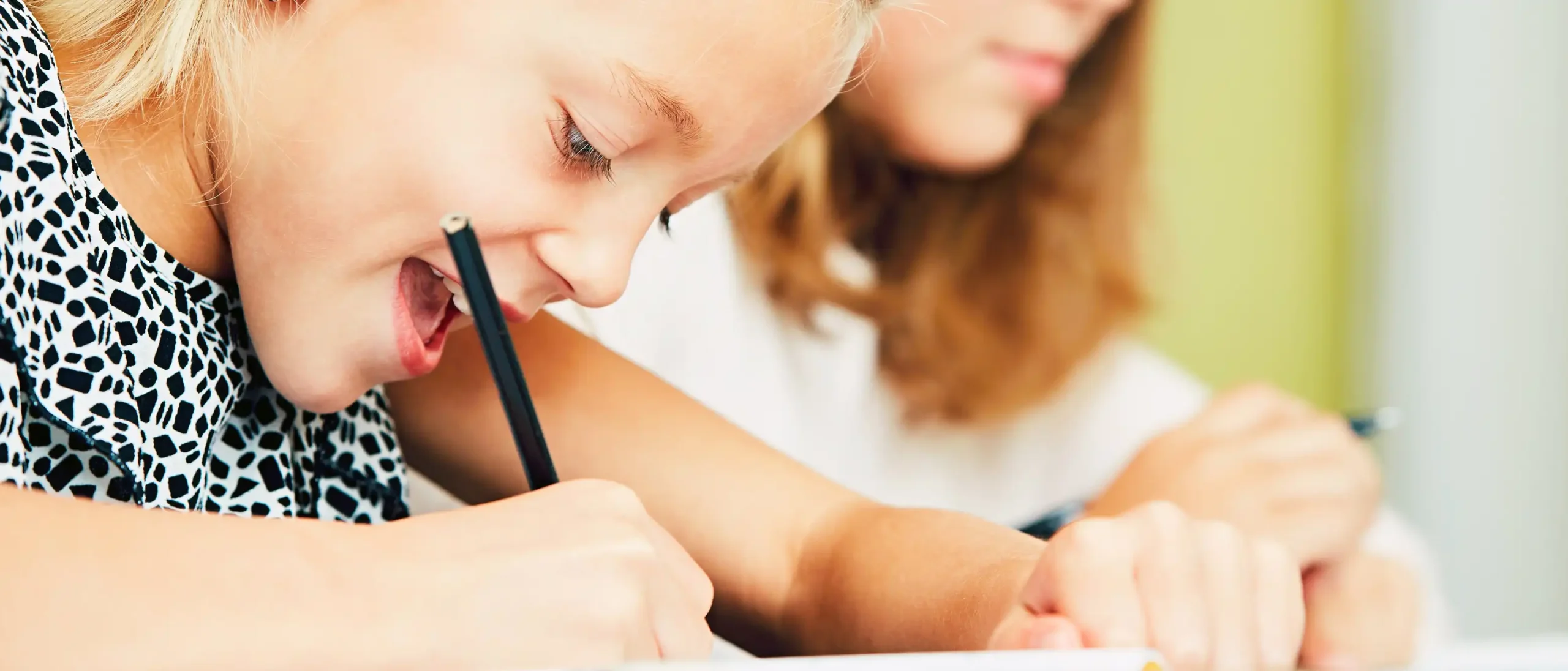
The Key to Handwriting Success: Getting It Right the First Time
This is a guest post by pediatric occupational therapist Katherine Collmer, M.Ed., OTR/L.
Handwriting is a skill just like baseball, keyboarding, and carpentry. It begins with interest, instruction, and practice, finally developing into mastery. Skill development depends upon this process as it provides opportunities for learning and growth in the specific area of interest. Skill mastery, however, is directly related to the efficiency of the instruction in the foundational concepts of that skill. Learning the appropriate procedures and habits the first time prevents the very difficult task of unlearning poor habits later.
Handwriting mastery depends upon the achievement of a complex set of skills: Cognitive, Visual/Sensory, and Physical. It is a developmental skill that starts with the manipulation of infant and toddler toys, progresses through scribbling and drawing, and begins to take the shape of letters and numbers in the pre-kindergarten years. Pencil grasp develops in stages, as well, working through feeding utensil grasp, to four-finger grasps, and finally, a dynamic tripod grasp when the child’s hands and fingers are ready to accept a pencil. The visual-motor skills needed for tasks that place a large demand on the eyes, such as handwriting and reading, begin to develop at birth but are not ready to spend sustained hours on those tasks until around the ages of 4.5-5 years.
The first key to “Getting It Right the First Time” is waiting for the right time. Rushing into handwriting can rob a child of the important learning and growth opportunities that will make the difference between success and failure. As children arrive at the developmental milestones that are appropriate for the introduction of handwriting, it is important to provide them with instruction and practice that will foster its mastery, as well as maintain their interest in its use and development. Let’s take a look at five facets of instruction that can lead to effortless and enjoyable handwriting skills and avoid challenging handwriting struggles.
Five Facets of Successful Handwriting Instruction
1. Body Awareness
The initial step for handwriting success begins with the children themselves. Body awareness is our “internal image” – our ability to “see” where our body parts are in space without having to look at them. It is developed through the collection of auditory, visual, tactile, proprioceptive, and vestibular input.
Body awareness skills unfold during movement activities that provide children with opportunities to experiment with how their bodies work and the ways they can make them work for them. An accurate sense of body awareness provides us with an understanding of directional concepts such as “left and right” and “up, down, back, and front” on ourselves and on objects in space. Plenty of movement games, such as body alphabets and air writing, as well as the inclusion of directional terms during handwriting sessions, can turn instruction into more effective learning. Body awareness lays the groundwork for the directional concepts needed for success in handwriting, reading, and math.
2. Vision Skills
Vision is more than 20/20 eyesight and involves 17 underlying visual skills. From birth, the eyes lead the body in learning and provide children with most of the information they will gather about themselves and the world. Vision puts everything that a child experiences into perspective as it makes sense of distance, depth, color, flexibility, and texture.
Given that students spend 30-60% of their time working on fine-motor activities that place a huge demand on their visual skills, it makes sense that efficiency in this area will lead to more positive classroom experiences. Frequent modeling of appropriate pencil grasp and letter formations, visual cues for spacing, and plenty of opportunities for guided practice help students develop good visual motor skills. Automatic and legible handwriting depend upon these visual skills for ease and efficiency.
3. Posture
“Shoulders back, eyes front and center!” Postural efficiency depends upon the adequate development of the muscles and coordination of the head, eyes, trunk, arms, legs, and feet. Strength in these areas allows us to sit tall without having to think about it. Poor muscle strength results in poor posture that requires the diversion of attention and concentration skills in order to “sit up, please!” This redirection of skills robs children of their ability to focus on the task at hand.
In addition, slouching diminishes the blood flow to the brain and the transfer of “fresh air” needed for concentration. Leaning close to the desk or resting our head on our arm skews the images traveling through the eyes to the brain resulting in possible eye strain and poor visual skill development. Good posture in the classroom begins with appropriately sized desks and chairs, with the help of adaptations if necessary, to keep the elbows, hips, knees, and ankles in 90-degree angles. The learning and memory skills necessary for handwriting mastery can only be as efficient as a student’s ability to sit tall, attend, and concentrate.
4. Pencil Grasp Efficiency
Pencil grasp development is the product of efficient visual, physical, and fine-motor skills. Visually, the eyes lead the hand in efficient fine-motor movement. Physically, strong shoulders provide stability for good seating posture and fluid, controlled arm movements. Strong fingers and hands allow for the dexterity needed for pencil manipulation and control. Fine motor skills are developmental and follow a process that includes scribbling, drawing, and coloring with chalk and crayons.
A child’s hands and fingers are ready for the introduction of a pencil around the age of four when the development of a tripod grasp begins to take shape. The preceding stages play a critical role in the development of pencil grasp and should not be rushed. The introduction of pencils before children are ready can lead to pencil grasps that will slow them down due to hand fatigue and poor letter formation. When they are ready, handwriting practice that includes work on a vertical surface naturally places a student’s wrist in the appropriate position and provides opportunities to practice fluid pencil movement. A desk guide that cues students to slant their paper before writing encourages a pencil grip that will reduce hand fatigue and increase legibility. An appropriate pencil grasp is a cornerstone of fluid and legible handwriting.
5. Effective Handwriting Practice
Paper positioning, pencil grasp, and posture are the three foundational “musts” for efficient handwriting practice. They set the stage for building good habits early and the formation of the appropriate motor patterns that allow for automatic handwriting skills. With these in place, handwriting mastery is achieved through the use of a structured handwriting program.
Handwriting is a skill that requires guided practice. Instruction that allows children to become active players in building those skills places the responsibility for mastery in their hands and builds pride in their work. Practice sessions that encourage creativity and foster interest in the art of handwriting lay the groundwork for continued use and development of handwriting skills. Journals, creative writing projects, assignment sheets, and letter writing are fun and easy ways to include handwriting practice in daily classroom sessions. Effective handwriting practice takes handwriting to a higher level by including it in everyday activities.
Getting it right the first time paves the way to a life filled with happy handwriting experiences!



